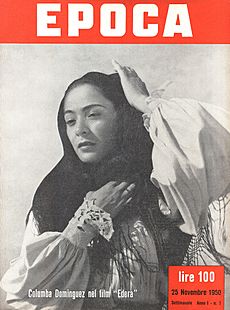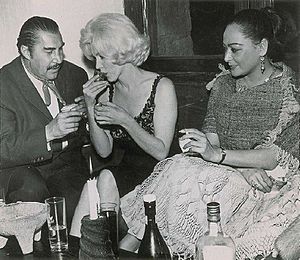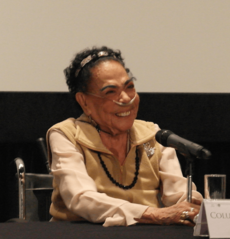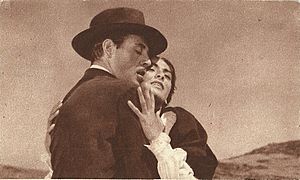Columba Domínguez facts for kids
Quick facts for kids
Columba Domínguez
|
|
|---|---|
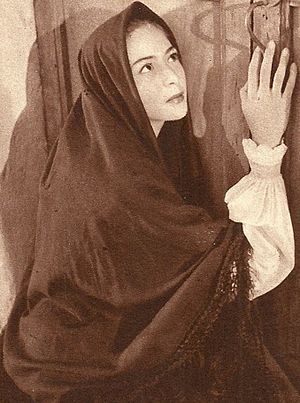
Domínguez in L'edera (1950)
|
|
| Born |
Columba Domínguez Alarid
March 4, 1929 |
| Died | August 13, 2014 (aged 85) |
| Resting place | Mausoleos del Ángel, Mexico City |
| Nationality | Mexican |
| Occupation | Actress, singer, painter |
| Years active | 1945–2014 |
| Partner(s) | Emilio Fernández (1947–1952) |
Columba Domínguez Alarid (born March 4, 1929 – died August 13, 2014) was a talented Mexican actress, singer, and painter. She is especially remembered for her amazing performance in the movie Pueblerina (1949).
Contents
About Columba Domínguez
Her Early Life
Columba Domínguez Alarid was born on March 4, 1929, in Guaymas, Sonora, Mexico. When she was very young, her family moved to Mexico City. One day, while at a party with her sister, she was discovered by a famous Mexican film director named Emilio Fernández. He helped her start her acting career with small roles in films like La perla (1945) and Río Escondido (1947).
Her Acting Career
In 1948, Emilio Fernández gave Columba a more important role in the movie Maclovia, where she acted alongside María Félix. Critics loved her performance! Because of this, Fernández chose her for the main role in what would become her most famous film: Pueblerina (1948). This movie made Columba a huge star very quickly, and she became known around the world after it was shown at the Karlovy Vary International Film Festival. That same year, she also appeared in La Malquerida with Dolores del Río and Pedro Armendáriz.
After the success of Pueblerina, Columba was invited to Italy to act in the film L'Edera (1950). In the same year, she filmed Un día de vida (1952). This movie wasn't very popular in Mexico, but it became a huge hit in the country that used to be Yugoslavia.
Columba often played roles that showed her as a strong, traditional Mexican woman. In 1952, she started working with other directors, which helped her become an even bigger star. She worked with famous filmmakers like Luis Buñuel in El río y la muerte (1955) and Fernando Méndez, who directed the classic horror film Ladrón de cadáveres (1957). She also starred in two masterpieces by Ismael Rodriguez: Los Hermanos de Hierro (1961) and Ánimas Trujano (1962), where she acted with the Japanese star Toshirō Mifune. In 1962, her film El tejedor de milagros represented Latin America at the Berlin Film Festival.
Columba also had a singing career! In 1961, she released an LP record called La voz dulce y mexicana de Columba Domínguez (The Sweet, Mexican Voice of Columba Domínguez). It was released by RCA Víctor and featured beautiful orchestral music. This album was re-released digitally in 2012 by Sony Music.
On television, Columba acted in popular telenovelas (soap operas) like La tormenta (1967) and El carruaje (1972). Her last TV role was in Aprendiendo a amar (1979).
After stepping back from acting in 1987, Columba spent her time on dance, art, painting, and playing the piano. In 2008, after more than 20 years away from movies, she returned to the screen in a short film called Paloma. That same year, she was honored at the International Film Festival de la Frontera in Ciudad Juárez, where some of her best films were shown. She also made special appearances in the films La cebra and Borrar la memoria in 2010, and El último trago in 2012.
In May 2013, Columba Domínguez received the Golden Ariel Award. This is a very special award that celebrates her amazing contributions to the Mexican film industry.
Her Personal Life
Columba Domínguez was discovered by the famous director Emilio Fernández in 1945. They developed a close relationship and had a daughter named Jacaranda, who was born in 1952. Due to personal differences, Columba decided to leave Emilio in 1952 and took their daughter with her.
Sadly, their daughter Jacaranda passed away in 1978.
Columba and Emilio remained connected throughout their lives. She was with him during his final days in the hospital, even though they had been apart for many years. In March 1987, she wrote a book called Emilio, the Indian that I love, which was dedicated to him.
Columba's unique Mexican beauty was captured in paintings by famous artists like Miguel Covarrubias, Jesús Guerrero Galván, and Diego Rivera.
Her Passing
Columba Domínguez passed away on August 13, 2014, at the Hospital Ángeles Santelena in Mexico City. She had been in the hospital for a few days due to pneumonia and died from a heart attack. She was buried at the Mausoleos del Ángel Graveyard in Mexico City.
Selected Films
Features
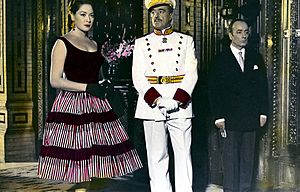
- La Perla (1947)
- Río Escondido (1948)
- Maclovia (1948)
- Pueblerina (1949)
- The Unloved Woman (1949)
- L'edera (1950)
- Un día de vida (1951)
- La Bienamada (1952)
- Reportaje (1953)
- Women Who Work (1953)
- Historia de un abrigo de mink (1953)
- El río y la muerte (1957)
- Esposas infieles (1956)
- La Virtud Desnuda (1956)
- Ladrón de Cadáveres (1957)
- Cabaret Trágico (1958)
- Pan, amor...y Andalucía (1959)
- Los hermanos Del Hierro (1961)
- Ánimas Trujano (1962)
- Pueblito (1962)
- El tejedor de milagros (1962)
- Paloma herída (1963)
- La Loba (1965)
- Las Momias de Guanajuato (TV) (1966)
- La tormenta (TV) (1967)
- Mi niño Tizoc (1972)
- Los Ricos Tambien Lloran (TV) (1979)
- Aprendiendo a Amar (TV) (1979)
- Una gallina muy ponedora (1982)
- Paloma (2008)
- La Cebra (2010)
- Borrar la Memoria (2010)
- El último trago (2012)
- Ramona (2014)
Her Music Albums
- La voz dulce y mexicana de Columba Domínguez (RCA Víctor, 1961)
Side one:
- "La pajarera"
- "Pregones de México"
- "Nunca"
- "Se me hizo fácil"
- "Dime si me quieres"
Side two:
- "Xochimilco"
- "Te amaré vida mía"
- "Nunca, nunca, nunca"
- "Paloma mensajera"
- "La barca de Guaymas"
See also
 In Spanish: Columba Domínguez para niños
In Spanish: Columba Domínguez para niños


